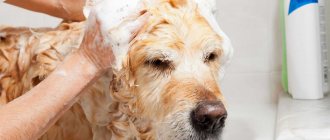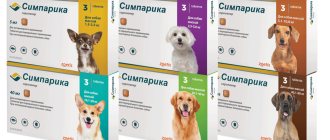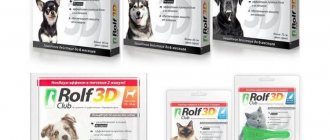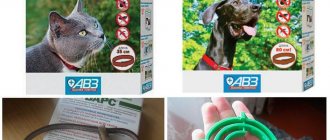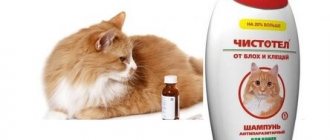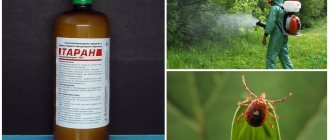Not everyone is happy with the spring sun, drops and the appearance of the first green grass. During this period, dog owners are worried about their four-legged friends: the time of ticks is coming. Ixodid ticks are carriers of many dangerous diseases that pose a threat to both people and animals. That is why every caring owner, with the arrival of spring, wonders if any new means of protection against these insects have appeared, which of them are the most effective and at the same time the least safe for their pets.
Protecting your friend from these insatiable bloodsuckers is not difficult, but you need to know which ones are best for your animal. Today, the range of these products in specialized stores is quite diverse: these include tablets, shampoos, dry formulations, collars, and sprays.
But most pet owners (and veterinarians support them in this) believe that anti-tick sprays (for dogs) are the most convenient to use, effective and mostly safe. What is the advantage of drugs in this form? We will try to figure this out in our article. We will also name the best anti-tick spray for dogs. The rating of these popular products may help you choose the drug that is more suitable for your four-legged friend.
Types of sprays
So, let's figure out what these drugs are and how they act on hated insects. Antiparasitic agents, produced by different manufacturers in the form of sprays, are always popular. This is due to their effectiveness and quick results after use. The active substances enter the tick's body through the respiratory system.
All anti-tick sprays for dogs are divided into two types:
1. Acaricides, which are intended for poisoning and further destruction of parasites on the dog’s body.
2. Repellents are less toxic preparations that, as a rule, do not kill parasites. They are used to protect the animal before visiting dangerous places (a trip out of town, to the country), as they are able to repel insects.
The sprays contain insecticides. The following poisonous substances are especially often used:
1. Permethrin
The most famous insecticide that can be found in almost all antiparasitic drugs. This substance is designed to quickly and effectively kill ticks, so it has a fairly high degree of toxicity. For this reason, owners should exercise caution when using permethrin-based products.
2. Fipronil
Another widely used insecticide, which is included in many sprays and more. It is used in the manufacture of special collars that are used to protect animals. The substance is also toxic, but recently veterinarians have noted that anti-tick spray for dogs (reviews from owners confirm this) even with a high content of this substance does not cope very effectively with its main task. This is probably due to the development of immunity in ticks, so this insecticide is increasingly less often included in protective products.
3. Neostomazan
More recently, it was the main component in most antiparasitic drugs, but over time it could not withstand competition with more effective and modern analogues. However, today it can be purchased in pet stores as an independent means to combat ticks or found as part of some medications.
4. Essential oils
These are not poisonous substances, but they are also included in many sprays, mainly for repellents. They are designed to repel parasites. Their effectiveness is not so high, but the advantage is that this component is non-toxic and therefore completely safe. The most commonly used oils are eucalyptus and citrus fruits.
The vast majority of antiparasitic agents, especially acaricides, are toxic substances and must be used carefully. Anti-tick sprays for dogs, without exception, are supplied with instructions - both foreign and domestic manufacturers. It must be strictly observed and in no case should the norms and processing rules specified therein be changed.
General information
The tablets are classified as insecticides; they differ fundamentally from each other in composition and the active substance used (fluralaner, afoxolaner, spinosad, milbemycin, sarolaner, etc.)
Each active substance has its own purpose. According to the direction of action, the active substances work to destroy internal parasites living in the gastrointestinal tract and/or to destroy external parasites living on the skin (fleas, ticks, etc.)
Manufacturers produce these drugs based on the weight and age of the pet. Based on this, the appropriate dosage and frequency of use are selected.
The territory where the pet lives is also taken into account; the number of ticks in each specific region or locality may differ significantly, etc.
"Frontline"
The composition is the development of French specialists. Available in different forms, including spray. Many owners, including veterinarians, believe that this is the best anti-tick spray for dogs.
Anti-tick spray for dogs "Frontline" has an undeniable advantage: its versatility - it can be used to treat not only dogs, but also cats. It will protect your pets not only from ticks, but also from fleas.
The main active ingredient in this spray is fipronil, so you must strictly follow the instructions. The average price in Russia is about a thousand rubles per 100 ml bottle.
Briefly about the main thing
- Drop treatment for ectoparasites is the most popular among dog owners, and a large selection allows people with different budgets to use this treatment method.
- Many drops have a wide spectrum of action, so that in one treatment the dog can be protected from both ticks and worms.
- It is very important to observe safety precautions and follow the instructions when using drops.
All drugs have both positive and negative reviews. You should not rely entirely on them, and if you have any doubts or questions, you should first consult your veterinarian.
Bolfo
This is the German analogue of the Frontline spray presented above. However, it has a significant difference: its main active ingredient is propoxur, not fipronil. Experts consider it a safer composition. Even if it accidentally gets on the mucous membranes, it will not cause serious irritation.
Anti-tick spray for dogs "Bolfo" is available in 250 ml cans. Its average price today is 500 rubles.
How do the drops work?
Drops can have both a repellent (repellent) and acaricidal (destroying) effect; more often, these effects are combined in many drugs.
The repellent effect is achieved due to the content of special components in the preparation, the smell of which insects do not like. Thanks to this, they not only do not bite the animal, but do not even sit on it.
The destructive effect occurs as a result of the absorption and accumulation of active substances in the dog’s epidermis. If the parasite does manage to bite a pet, the “poison” will enter their body and cause paralysis.
Hartz
A well-known American manufacturer of pet products also produces an anti-tick spray for dogs. Its main active ingredient is tetrachlorvinphos. This product should not be used with other medications. Specialist consultation is required.
The substance should be sprayed carefully, as if it gets on the mucous membranes, irritation may occur. You're probably wondering how much anti-tick spray for dogs from this well-known manufacturer costs? A large 475 ml bottle will cost you about 600 rubles.
Where can I buy
You can purchase anti-tick products either at a veterinary pharmacy in your city or by using the services of an online store. Typically, websites provide a wider range of medications, supplemented with new products in this area, and you can also read real reviews from other customers.
If the user is interested in specific manufacturers or other criteria, then it is worth selecting the necessary filters: a list of the most popular models will be provided upon request. You can also choose from budget options to the most expensive.
Each product has a detailed description with all the characteristics: what weight of the animal the tablets are designed for, for an adult or a puppy, as well as the number of tablets in one package, the price of the product. Advice from other users who have already purchased products will help you make a quicker choice.
After the final selection of a specific drug, an order is made online, and the product is sent to the customer within the time period agreed with the manager.
Anti-tick spray for dogs "Bars"
This is the best domestic remedy, well known to many dog owners. The drug is produced in Russia in the form of drops and spray. The drops retain their properties for two months. One pipette is enough to treat a dog weighing from two to ten kilograms.
The effect of the spray is not so long - no more than two weeks. Anti-tick spray for dogs "Bars" is designed both to destroy parasites and to repel them. This allows you not only to rid your pet of ticks, fleas and other parasites present on the body, but also to use it as a preventive measure.
This flea and tick spray for dogs costs 220 rubles (100 ml bottle).
Reviews from owners and veterinarians
Bravecto. The drug is new on the market, so it is not yet in high demand. However, those who have already tried it are satisfied with its effectiveness.
Inspector. The owners give this drug a solid five. no side effects were observed.
Advantix. Based on numerous reviews, we can say that the drops work great. Some owners have noted an allergic reaction in their pet. Also, many are not satisfied with the high cost of the drug.
Advocate. 51 out of 53 owners wrote exclusively positive reviews for this drug. Users are pleased with the wide spectrum of action of the drops, the ability to protect against internal parasites and ease of use.
Frontline. Owners note the high efficiency, convenience and safety of these drops.
Fiprist. 14 out of 18 positive reviews. Some noted an allergic reaction and a bad odor from the drops.
Leopard. Cheap and effective. Many owners prefer this particular drug. Although negative reviews also slip through.
BlochNet. 88 out of 121 owners gave these drops a 5 rating. Excellent value for money and quality.
Stronghold. Owners are pleased with the wide spectrum of action and effectiveness of the drug. Some noted the high cost of the drops.
Practically tick. A good affordable remedy, but an allergic reaction is possible.
Vectra 3D. Most people do not recommend these drops for treating dogs.
Rolf Club 3D - Owners note the ineffectiveness of the drops and an allergic reaction in the pet.
Dana. In general, the owners are satisfied, but many noted an allergic reaction in their dogs.
IN-AP. A wide spectrum of action, long-lasting action and effectiveness - all this is considered by owners to be “advantages” of these drops.
Celandine. There are both positive and negative reviews. Some noted the effectiveness of the drug, others say that the drops do not help at all.
As for veterinarians, they do not give preference to any particular drug. The main thing is to follow the instructions and safety measures.
Rules for treating animals with spray
- It is advisable to carry out the treatment in the fresh air. If this is not possible, then perform this procedure in a well-ventilated area. If there is an aquarium in this room, it is better to take it to another room, since tiny particles of the drug may remain in the air, to which the fish are very sensitive.
- Wear a respiratory mask and disposable rubber gloves to reduce the risk of vapors entering your respiratory tract and to avoid contact of the product with your skin.
- The spray can is kept strictly vertical during processing. The product is sprayed only against hair growth. Carefully ensure that the drug is spread evenly in layers throughout the animal’s body.
- If your pet has thick and long hair, then anti-tick sprays for dogs should be applied by parting the fur with your hands so that the product is better absorbed into the skin.
- When spraying the preparations near the animal's head, close its eyes, ears, mouth and nose.
- After treatment, the dog should be visible until the product dries completely. Do not allow the animal to lick it to avoid poisoning.
Features of using various means
All types of anti-tick medications have their own characteristics of use. The tablets are mixed with food without crushing, if the instructions allow this method. The drug cannot be crushed. The safest option is to put the tablet directly into the mouth as close to the throat as possible. This can be done either manually or using a special syringe.
The collar is placed on the animal's neck. It is important to ensure that there is some free space between it and the wool. If necessary, the collar can be shortened using scissors. He shouldn't sit too loose either.
Shampoos are applied during bathing. It is important to moisturize the dog's fur first. Only after this can the product be applied. Soap suds after bathing are washed off with warm water.
Sprays are sprayed onto the animal's fur from a distance of 10-15 cm. There is no need to do this too close. It is important to ensure that the medicine does not get into the animal's eyes. This also applies to shampoos.
Anti-tick sprays for dogs: advantages and disadvantages
The popularity of sprays is understandable. These drugs have many positive qualities. Among them:
- the ability to use as a prophylactic agent;
- quick treatment results;
- anti-tick spray for dogs, unlike drops, affects only the fur and skin and does not enter the body;
- ease of use.
Despite their undeniable advantages, sprays also have disadvantages:
- It is not very convenient to handle long-haired animals;
- if treated unevenly, some insects may survive;
- allergic reactions are possible;
- short-term therapeutic effect.
Safety precautions and contraindications
Proper use of the medicine is completely safe for the animal. It is necessary to take into account all the doctor’s recommendations. You need to understand that each drug has an individual set of contraindications. You need to familiarize yourself with them in advance. Typically, tick repellent tablets are prohibited for use if you have certain medical conditions. If you ignore the list of contraindications, the animal may experience complications that cannot be eliminated.
All drugs are prohibited for use if the dog has an individual intolerance to specific substances.
Particular care should be taken when choosing a medication if the dog has any chronic diseases, is in the pregnancy stage, is nursing, or has problems with the urinary system.
The dosage is selected individually. It is imperative to take into account the age and weight of the dog.
Important. Some medications are not recommended for use in young dogs and puppies.
If after taking the medicine such unpleasant signs as vomiting, lethargy, tremors, refusal to eat, or weakness appear, then you must immediately take the dog to the clinic. People must also observe safety measures. Immediately after contact with the drug, you should wash your hands thoroughly. The medicine is kept away from children.
Efficacy of drugs
All sprays demonstrate a high level of effectiveness almost immediately after treatment, instantly affecting parasites or protecting against their attack. However, this indicator directly depends on the following factors:
- Pet's fur length.
- Composition of the product.
- Strict adherence to all processing rules.
Regardless of what insecticide is included in the spray, these drugs act according to the same principle, which can be described as follows:
- The toxic substance enters the tick's body through the digestive or respiratory system, through direct contact through the chitinous cover.
- The insecticide provokes disruptions in the central nervous system of insects.
- The active substance affects only arthropods and insects; it does not affect warm-blooded organisms.
- Ticks lose their viability because they are deprived of the ability to move, eat, and breathe.
How to use the tablets correctly
Anti-tick tablets should be used monthly. The duration of treatment directly depends on the degree of neglect of the pathology, the number of parasites and the region of residence. Consultation with a doctor is required. Changing the prescribed dosage on your own may have a negative impact.
When taking the drug, be sure to take into account the dog’s age and weight. If there are individual characteristics, for example, pregnancy, then you must inform your doctor about this. Most often, tablets are prohibited for pets under 2 months of age. In this case, more gentle medications are needed.
Usually the capsules have a meaty taste, which makes treatment easier. Despite this, you need to make sure that the animal actually ate the medicine.
What should you pay attention to?
When choosing a spray to combat ticks, pay attention to the following factors:
- Toxicity of the drug, which depends on the active substances.
- If you are going to treat an elderly or weakened animal or puppy, give preference to drugs with a mild effect.
- The volume of the can. This criterion is usually determined by the size of the dog and the length of the coat: the higher the indicators, the more drug you will need.
- Compatibility with other means if comprehensive control of parasites is planned.
- Brand of drug. We recommend buying products from well-known brands that have proven themselves well.
- Duration of the therapeutic effect. Sprays differ in the period of validity guaranteed by the manufacturer; it must be indicated in the instructions for the drug.
Selection of products for dogs of different breeds and sizes
There are several important factors that must be taken into account. First of all, you need to decide on the form of the product. As mentioned earlier, tablets are the most effective option.
The age of the dog must be taken into account. Most standard medications are not given to puppies until they are 8 weeks old. It is also important to pay attention to weight. Some medications have restrictions on this parameter and are not used for dogs weighing up to 1.2 kg.
If the dog is an adult, then almost any drug will do. If a puppy needs treatment, it is advisable to give preference to shampoos. They are less effective, but completely safe for a small individual.
Breeds weighing more than 20 kg are given only tablets. Other options will not be effective. Otherwise, breed and coat type do not influence the choice of medication in any way.
Reviews from dog breeders
Many dog owners have long and successfully used anti-tick sprays for dogs to care for their pets. Almost all manufacturers receive reviews. Many animal owners note that with prolonged use of Frontline spray, which works well against ticks, the animal may experience an allergic reaction, so it should be periodically changed to another drug.
And one more tip: this spray is quite often counterfeited, so you need to buy the product only from a French manufacturer in large pet pharmacies.
Most of the sprays described above are effective and easy to use, but to choose a product individually for your pet, do not take risks and seek advice from a veterinary clinic. Experienced dog breeders recommend the same when allergic reactions to any drug occur.
Types of ticks and signs of their bites
Before you look for where to buy dog tick repellent, you need to find out what types of these parasites there are. In most cases, pets are bitten by 3 types of bloodsuckers. Each of them suffers different diseases, accompanied by many unpleasant symptoms.
Dangerous types of parasites and signs of their bites:
- Subcutaneous. This type of tick is most often found on the dog's body. It digs deep into the skin and becomes very difficult to remove. The subcutaneous bloodsucker carries such dangerous diseases as demodicosis and anemia, so animal owners need to identify the pest as quickly as possible. The main signs of its bite are itching, hair loss, and high fever.
- Itchy. This tick is considered one of the most dangerous. It constantly moves along the animal’s body, periodically biting it and leaving characteristic marks called “white holes.” This bloodsucker infects dogs of different breeds and carries dozens of diseases. Its attack on a pet can be detected by falling fur and a red rash on the skin. In addition, the animal develops severe itching, the temperature rises and sleep is disturbed.
- Pyroplasmic. This parasite bites dogs quite often. It suffers from various blood diseases, the lack of timely treatment of which leads to serious problems with the pet’s kidneys and liver. You can determine the presence of a tick on a dog’s body by high temperature, lack of appetite, severe itching and general lethargy.
Rules for applying liquid sprays
Before you start treating your dog, you should be sure to read the instructions, since many anti-tick agents are applied in different ways. You should also familiarize yourself with the contraindications.
To achieve maximum efficiency during the procedure, you must adhere to the following rules:
- The dog should not be washed or bathed 3 days before and 3 days after.
- Before starting the procedure, the skin must be dry.
- Shake the bottle well before use.
- Spray against the direction of hair growth.
- You should spray the spray not on the dog’s fur itself, but on the skin or undercoat, pushing the long hairs apart with your fingers.
- Treatment with an aerosol preparation is done at a certain distance from the animal.
- The spray area depends on the purpose: for protection, the dog’s entire body should be treated; if a tick is present and detected, the fur around it should be parted and treated; to protect against fleas, the pet’s withers and spine should be sprayed with a spray.
- After drying, the coat must be combed.
- The spray should be sprayed simultaneously both on the pet and on its resting place (bedding, kennel, etc.).

